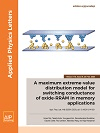
APPLIED PHYSICS LETTERS
Scope & Guideline
Empowering Scholars with Rapid Research Insights.
Introduction
Aims and Scopes
- Nanotechnology and Materials Science:
APL publishes studies on the synthesis, characterization, and application of nanomaterials, including quantum dots, nanowires, and thin films, focusing on their unique properties and potential applications in electronics, optoelectronics, and energy storage. - Optoelectronics and Photonics:
The journal features research on light-emitting diodes (LEDs), lasers, photodetectors, and other optoelectronic devices, emphasizing innovations that enhance performance and efficiency, particularly in the ultraviolet, visible, and infrared spectra. - Spintronics and Magnetism:
APL covers advancements in spintronic devices, including magnetic tunnel junctions, spin Hall effects, and skyrmions, concentrating on their applications in data storage and quantum computing. - Ferroelectric and Dielectric Materials:
Research on ferroelectric materials and their applications in memory devices, actuators, and sensors is a key focus area, with attention to the effects of doping, interface engineering, and structural modifications. - Thermoelectric and Energy Conversion Materials:
APL publishes studies on materials that convert thermal energy into electrical energy (and vice versa), exploring new thermoelectric materials and devices aimed at improving energy efficiency and sustainability. - Quantum Technologies and Devices:
The journal includes research on quantum dots, quantum computing, and related technologies, addressing theoretical and experimental aspects that contribute to the advancement of quantum information science.
Trending and Emerging
- Two-Dimensional Materials:
Research on two-dimensional materials, such as graphene, MoS<sub>2</sub>, and other transition metal dichalcogenides, is gaining momentum due to their unique electronic, optical, and mechanical properties, making them suitable for various applications in electronics and optoelectronics. - Machine Learning and AI in Physics:
The adoption of machine learning and artificial intelligence techniques in experimental and theoretical physics is on the rise, enabling faster data analysis, material discovery, and optimization of device performance. - Quantum Computing and Information Science:
There is an increasing focus on quantum technologies, including quantum computing, quantum sensors, and quantum communication, as researchers explore the potential of quantum mechanics to revolutionize information processing. - Flexible and Wearable Electronics:
Research into flexible and wearable electronic devices is rapidly expanding, driven by advancements in materials, such as organic semiconductors and 2D materials, which allow for the development of lightweight, adaptable, and efficient devices. - Sustainable Energy Technologies:
Emerging research on sustainable energy solutions, including organic photovoltaics, advanced battery technologies, and thermoelectric materials, reflects a growing commitment to addressing environmental challenges and energy efficiency. - Spintronic Devices and Magnetic Materials:
The study of spintronic devices and materials, particularly those that leverage new phenomena such as skyrmions and topological effects, is increasingly relevant as researchers seek to enhance data storage and processing capabilities.
Declining or Waning
- Traditional Semiconductor Devices:
There has been a noticeable shift away from research focused solely on conventional semiconductor devices towards more advanced materials and structures, such as two-dimensional materials and quantum dots, which offer enhanced performance and novel functionalities. - Bulk Material Studies:
Research centered on bulk materials and their properties has decreased as the focus has shifted towards thin films, heterostructures, and nanostructures, which are more relevant for current technological applications. - Classic Ferromagnetic Materials:
Studies on classic ferromagnetic materials and their applications have seen a decline, with a growing emphasis on novel magnetic materials, such as topological insulators and two-dimensional magnets, which present unique properties and potential for new applications. - Optical Coatings and Conventional Photonics:
The exploration of traditional optical coatings and photonics has waned as the field increasingly embraces advanced metasurfaces and nanophotonic devices that offer greater versatility and functionality.
Similar Journals
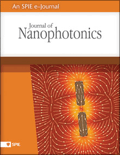
Journal of Nanophotonics
Advancing Photonics Through Innovative ResearchThe Journal of Nanophotonics, published by SPIE-SOC Photo-Optical Instrumentation Engineers, is an esteemed platform dedicated to advancing the field of nanotechnology through pioneering research in photonics. Since its inception in 2007, this journal has become instrumental in disseminating innovative findings and fostering collaborative discussions, especially in the domains of Condensed Matter Physics, Electronic, Optical and Magnetic Materials, and Nanoscience and Nanotechnology. Currently ranked within the Q3 category across these fields, it serves as a vital resource for academics, industry professionals, and students keen on exploring the multifaceted applications and implications of nanophotonic technologies. With its convergence set to continue until 2024, the journal offers a non-open-access model, ensuring rigorous peer-review standards and high-quality publications that contribute to the global body of knowledge.
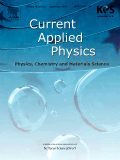
CURRENT APPLIED PHYSICS
Connecting Ideas, Driving Discoveries in Applied Physics.Current Applied Physics is a leading journal published by Elsevier, specializing in the dynamic fields of Physics and Materials Science. With an ISSN of 1567-1739 and an E-ISSN of 1878-1675, this journal focuses on the latest advancements and applications of physics principles in various practical domains. Operating from the innovative hub of Amsterdam, Netherlands, Current Applied Physics occupies a significant niche in the scientific community, evidenced by its Q2 ranking in both the Physics and Astronomy and Materials Science categories for the year 2023, along with impressive Scopus rankings that highlight its relevance in the fields of General Physics and General Materials Science. The journal's scope encompasses a wide range of topics, fostering interdisciplinary collaboration and facilitating the exchange of knowledge among researchers, professionals, and students. Each issue features peer-reviewed articles that contribute to the understanding and application of physical sciences, making it an essential resource for those aiming to stay at the forefront of research and innovation in applied physics.
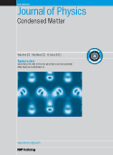
JOURNAL OF PHYSICS-CONDENSED MATTER
Illuminating the Evolving Landscape of Materials Research.JOURNAL OF PHYSICS-CONDENSED MATTER, published by IOP Publishing Ltd, stands as a premier platform for the dissemination of impactful research in the fields of condensed matter physics and materials science. Since its inception in 1989, this journal has successfully bridged the gap between fundamental and applied research, delivering cutting-edge findings pertinent to both the academic community and industry professionals. Ranking in the Q2 category for both Condensed Matter Physics and Materials Science, it holds a respectable position within the scientific community, as evidenced by its Scopus rankings. With a commitment to fostering innovative research and promoting open dialogue, the journal offers a substantial collection of articles that contribute to the evolving landscape of materials science and physics. Researchers and students are encouraged to engage with the journal’s rich content, which not only enhances their academic pursuits but also plays a crucial role in advancing technologies based on solid-state materials.
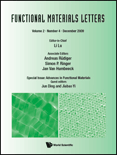
Functional Materials Letters
Driving innovation in materials science and engineering.Functional Materials Letters, published by World Scientific Publishing Co. Pte Ltd, is an esteemed academic journal dedicated to disseminating cutting-edge research in the field of materials science. Since its inception in 2008, the journal has provided a vital platform for researchers, professionals, and students to share their discoveries pertaining to functional materials, which are integral for diverse applications ranging from electronics to advanced manufacturing. With an ISSN of 1793-6047 and an E-ISSN of 1793-7213, the journal operates out of Singapore and maintains a notable presence in the global academic community, currently ranked in the Q3 quartile for materials science. Although it does not offer open access, the journal ensures that its publications are rigorously peer-reviewed, contributing significantly to the advancement of knowledge in this rapidly evolving field. Researchers aiming to stay at the forefront of materials science will find Functional Materials Letters an indispensable resource that highlights innovative findings and fosters collaboration among scholars.
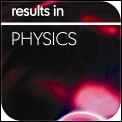
Results in Physics
Exploring New Frontiers in Physics ResearchResults in Physics, an esteemed open-access journal published by ELSEVIER, has been a prominent platform for disseminating cutting-edge research in the field of physics since its establishment in 2011. With its ISSN 2211-3797 and E-ISSN 2211-3797, this journal proudly holds a Q2 ranking in the Physics and Astronomy category for 2023, showcasing its significance and quality within the scientific community. With a remarkable Scopus rank of #28 out of 243 in the general physics and astronomy domain, placing it within the 88th percentile, Results in Physics serves as a vital resource for researchers, professionals, and students alike, fostering a collaborative environment for the advancement of knowledge across various subfields. The journal aims to provide a rapid and unrestricted access to innovative findings, encouraging open scientific dialogue and enhancing the visibility of breakthrough research. Located in the Netherlands at RADARWEG 29, 1043 NX AMSTERDAM, Results in Physics continues to uphold its commitment to excellence and accessibility in the ever-evolving landscape of physics research.

SEMICONDUCTORS
Advancing the frontiers of semiconductor research.SEMICONDUCTORS, published by PLEIADES PUBLISHING INC, is a prominent journal that provides a platform for researchers and professionals in the fields of Atomic and Molecular Physics, Condensed Matter Physics, and Electronic, Optical and Magnetic Materials. With an ISSN of 1063-7826 and an E-ISSN of 1090-6479, the journal has been diligently disseminating knowledge since its inception in 1996 and continues to pave the way for innovative research until 2024. Although currently unclassified in the Open Access model, its influence is underscored by its rankings in Scopus, where it ranks in the 21st-22nd percentile across critical scientific categories. SEMICONDUCTORS serves as an essential resource for cutting-edge research, fostering a greater understanding of semiconductor materials and their applications, thereby assisting the scientific community in pushing the boundaries of technology and innovation.

Science China-Physics Mechanics & Astronomy
Exploring the Frontiers of Mechanics and AstronomyScience China-Physics Mechanics & Astronomy, published by SCIENCE PRESS, stands as a prestigious journal within the Physics and Astronomy domain, particularly recognized for its contributions to the understanding of fundamental and applied physics. With an exhilarating Q1 ranking in the 2023 category and earning a remarkable scopus rank of #21 out of 243, the journal demonstrates its significant impact, being positioned in the 91st percentile of its field. Operating under an Open Access model, it facilitates the broad dissemination of high-quality research, ensuring accessibility for researchers, professionals, and students worldwide. Its scope covers a variety of essential topics in physics and astronomy, promoting a comprehensive understanding of the latest advancements from 2010 through 2024. The journal is a vital resource for anyone aiming to stay at the forefront of research in these dynamic fields, with its prominent address located in Beijing, China, symbolizing its global influence.
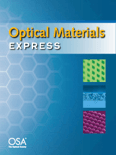
Optical Materials Express
Fostering collaboration in the science of light and materials.Optical Materials Express is a leading open-access journal dedicated to the rapid dissemination of research in the field of optical materials, published by the esteemed Optica Publishing Group. Since its inception in 2012, the journal has played a pivotal role in advancing knowledge and innovation in Electronic, Optical, and Magnetic Materials, currently maintaining a commendable Q2 classification in the 2023 category rankings. With a Scopus rank of 86 out of 284 in its category, the journal proudly boasts a 69th percentile positioning, underscoring its impact and relevance within the scientific community. The journal publishes high-quality, peer-reviewed articles that explore both fundamental and applied aspects of optical materials, making it an essential resource for researchers, professionals, and students alike. Located in Washington, DC, and accessible to a global audience, Optical Materials Express continues to foster collaboration and innovation among scholars in this vibrant field.

Journal of Luminescence
Pioneering Insights into Luminous PhenomenaThe Journal of Luminescence, published by ELSEVIER, is a leading interdisciplinary journal focused on the exploration of luminescence phenomena and applications across various scientific fields. Established in 1970, this prestigious journal has made significant contributions to the realms of Atomic and Molecular Physics, Biochemistry, Biophysics, Chemistry, and Condensed Matter Physics, as evidenced by its commendable Scopus rankings and category quartiles. As of 2023, it holds a Q2 ranking in multiple categories, indicating a robust impact in the community. The journal serves as a vital platform for researchers, professionals, and students alike, offering insights into the latest advancements in luminescence research and related applications, fostering innovation in both theoretical and experimental frameworks. The journal provides enriching content through its non-open access model, ensuring high-quality peer-reviewed research is accessible to those who prioritize impactful scholarly work. With a convergence period extending to 2025, the Journal of Luminescence continues to be an essential resource for those dedicated to the advancement of knowledge in the luminous sciences.

Physical Review Applied
Transforming Ideas into Practical SolutionsPhysical Review Applied is a prestigious journal published by the American Physical Society that serves as a vital platform for researchers in the field of applied physics. With an esteemed Q1 ranking in the Physics and Astronomy category and a commendable Scopus rank of #35 out of 243, this journal represents a significant milestone in disseminating cutting-edge research. Established in 2014, it focuses on the latest advancements and applications in various realms of physics, promoting interdisciplinary collaboration and innovation. Although not an open-access journal, Physical Review Applied offers a range of access options for readers and institutions, ensuring that high-impact research remains widely available. Researchers, professionals, and students alike will find this journal an essential resource for staying at the forefront of applied physics developments.